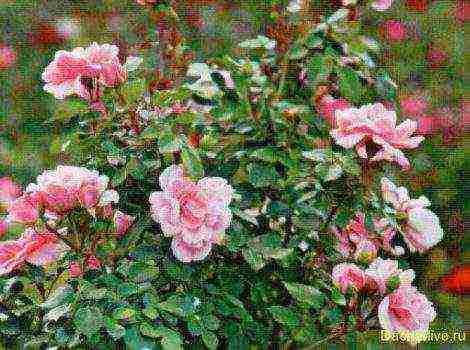Content
- 1 Tulip variety 'Gavota'
- 2 Tulip cultivar 'Recreado'
- 3 Tulip cultivar 'Olaf'
- 4 Tulip variety 'New Design'
- 5 Tulip cultivar 'Madame Spoors'
- 6 Tulip cultivar 'Happy Generation'
- 7 Tulip cultivar 'Lustige Witwe'
- 8 Tulip variety 'Alexander Puschkin'
- 9 Tulip variety 'Mascara'
- 10 Tulip cultivar 'Cancun'
- 11 Tulip variety 'Madame Curie'
- 12 Tulip variety 'Snowboard'
- 13 Tulip variety 'Grandma's fairy tales'
- 14 Tulip cultivar 'Orlenda'
- 15 Tulip 'Staning Apricot' cultivar
- 16 Tulip cultivar 'Anne Claire'
- 17 Tulip cultivar 'Preludium'
- 18 Tulip cultivar 'Tamara'
- 19 Tulip cultivar 'Emmy Peeck'
- 20 Tulip variety 'Pearl'
- 21 The nuances of tulip culture
- 22 Application
- 22.1 Simple
- 22.2 Terry
- 22.3 Triumph
- 22.4 Darwin hybrids
- 22.5 Simple
- 22.6 Lily-colored
- 22.7 Fringed
- 22.8 Greens
- 22.9 Rembrandt
- 22.10 Parrot
- 22.11 Terry
- 22.12 Kaufman
- 22.13 Foster
- 22.14 Greig
- 22.15 Wild
- 22.16 Grade 1 - simple early tulips
- 22.17 Grade 2 - double early tulips
- 22.18 Grade 3 - Triumph tulips
- 22.19 Grade 4 - Darwin hybrids
- 22.20 Grade 5 - simple late tulips
- 22.21 Grade 6 - lily-colored tulips
- 22.22 Grade 7 - fringed tulips
- 22.23 Grade 8 - green tulips
- 22.24 Grade 9 - Rembrandt Tulips
- 22.25 Grade 10 - parrot tulips
- 22.26 Grade 11 - double late tulips
- 22.27 Grade 12 - Kaufman tulips
- 22.28 Grade 13 - Foster's tulips
- 22.29 Grade 14 - Greig's tulips
- 22.30 Grade 15 - other types
- 23 General overview of the classification
- 24 Early flowering tulips. Group-I
- 25 Medium flowering tulips. Group-II
- 26 Late flowering tulips. Group-III
- 27 Species tulips. Group-IV
- 28 The largest varieties
Tulips of the garden class Triumph were bred at the beginning of the 20th century by crossing varieties of the Darwin hybrids and Prostnye Early classes. They are very much loved by both gardeners-breeders working with them, and summer residents who have successfully grown more than one variety on their site for more than one year. Triumph tulips are still proudly continuing their solemn procession, today they are the most representative garden class: their assortment makes up 25% of the entire world assortment of this flower culture.

Tulips Triumph in bloom, in the foreground the variety Gavota
Tulips of this class are characterized by large goblet flowers, rather tall (40-70 cm) strong peduncles and a good reproductive rate. The color of the flowers is very diverse: from pure white to dark purple. They bloom for quite a long time, starting from mid-April - early May, they keep the shape of the glass well.
Tulip variety 'Gavota'
A bicolor variety created in 1961.
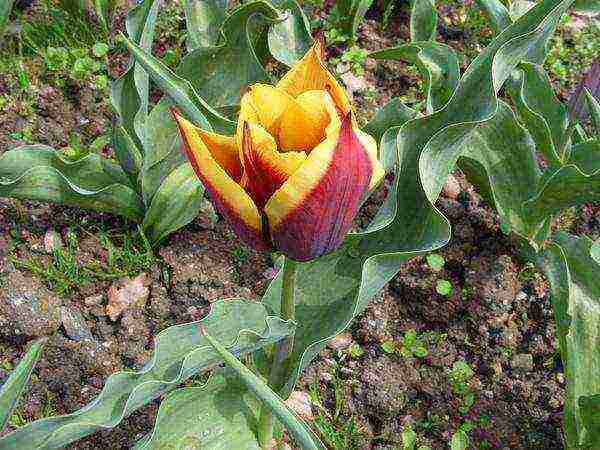
Tulip Gavota cultivar Plant up to 40 cm high, sturdy stem. Cup-shaped flower up to 8 cm high, purple-brown, with a light yellow border along the edge of pointed petals; blooms * from the second decade of April and blooms for 10 days. Resistant to diseases and unfavorable environmental factors, it can be affected by the variegation virus. Effective in the foreground of flower beds, suitable for forcing from January to March inclusive.
Tulip cultivar 'Recreado'
A mysterious strain created by Visser in 1979.
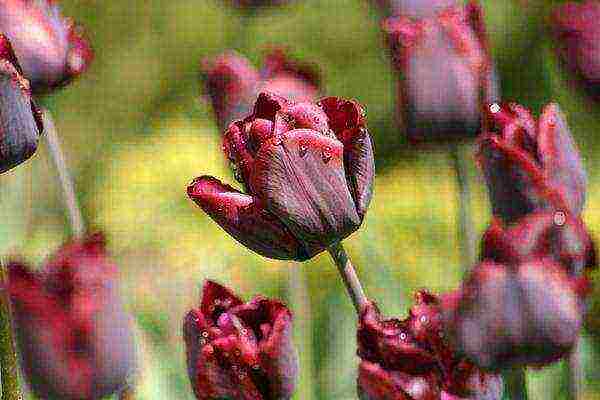
Tulip Recreado cultivar, photo A. Papkov Plant 30 cm high, sturdy peduncle. The flower is goblet, up to 8 cm high, dark purple. It blooms in 2-3 decades of April, duration - up to 10 days. Resistant to unfavorable weather conditions, can be affected by Fusarium and variegation virus. Suitable for spring flower beds, which brings mystery and sophistication. Well worth the cut.
Tulip cultivar 'Olaf'
This ruby red tulip was created in 1930.

Tulip Olaf grade It is low - up to 30 cm; the goblet flower is large, up to 9 cm high. It begins its bright flowering from the second decade of April, flowering lasts up to 20 days. Stable, but can be affected by variegation virus and fusarium.
Tulip variety 'New Design'
A very spectacular variegated variety bred by Toll in 1974.

Tulip cultivar New Design The tulip is not very tall (about 20-30 cm), the stem is strong, the edges of the leaves are bordered by a pink-white stripe. The flower is goblet, up to 9 cm high, white, with a wide pink border along the edge of the petals. It blooms from the 3rd decade of April, not for long (up to 10 days). Resistant to diseases and adverse weather conditions. Interesting in the foreground of spring mixborders, suitable for cutting and early spring (in March) forcing.
Tulip cultivar 'Madame Spoors'
Those who love variegated tulips (not to be confused with variegated tulips) should definitely take a look at this strain, created by Sandberger in 1985.

Tulip grade Madame Spoors Grade 45 cm high, sturdy stem. The flower is goblet, up to 9 cm high, dark crimson red, with a light yellow stripe along the edge of the petals. It blooms for 10 days, starting from the 2nd decade of April. Resistant to diseases and adverse weather conditions. Good for cutting and winter-spring forcing (from January to March inclusive).
Tulip cultivar 'Happy Generation'
An exquisite variety bred in 1969.
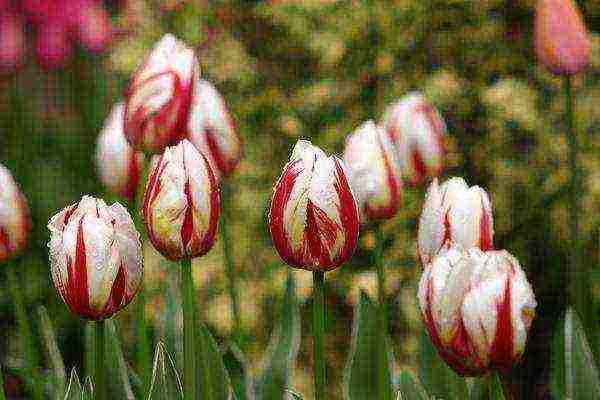
Tulip cultivar Happy Generation, photo A. Papkov Plant 50 cm high, sturdy stem, goblet flower, up to 9 cm high, white, with a crimson stripe in the center of the petals. It blooms from the 3rd decade of April (flowering duration up to 10 days). Resistant to unfavorable weather conditions, diseases and pests (in some years it is affected by fusarium and variegation virus). Good in spring flower beds, flower beds; it is impossible to pass by this variety without stopping for a minute to admire the interesting lines of the pattern on the petals. Suitable for cutting, forcing (from January to March inclusive).
Tulip cultivar 'Lustige Witwe'
The variety was created by A. May during the Great Patriotic War (in 1942).

Tulip cultivar Lustige Witwe Strong stem 40-50 cm high, flower up to 8 cm high, cupped, dark crimson, with a white stripe along the edge of pointed petals. It blooms from the 2nd decade of April for 2 weeks. Resistant to weather surprises and diseases, but can be attacked by the variegated virus.
Tulip variety 'Alexander Puschkin'
Similar to the previous variety, a novelty of Dutch breeding. It has already been presented on the site earlier.
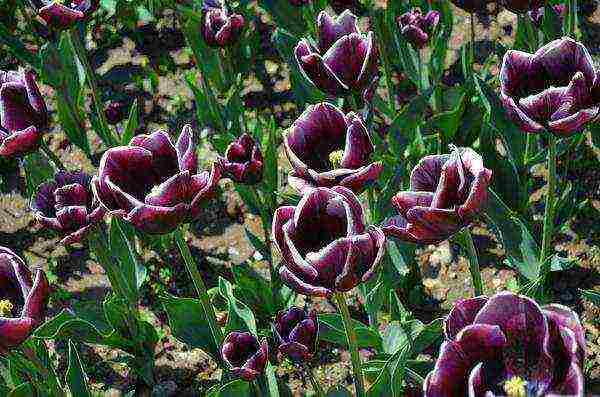
Tulip Alexander Puschkin grade Plant 40-45 cm high, sturdy stem, large flower, up to 8 cm high, maroon-purple, with a white border along the edge of the petals. Bloom more than 2 weeks. A very spectacular variety that will find its place in spring flower gardens; suitable for forcing from January to March.
Tulip variety 'Mascara'
A luxurious variety - a novelty of the Dutch selection.

Tulip cultivar Mascara Plant 45-55 cm high, sturdy peduncle, goblet flower, up to 8 cm high, dark red. It blooms from the 3rd decade of April for 10 days. Resistant to adverse weather conditions. Good in flower gardens, where it creates bright spots in the spring; suitable for cutting and forcing in the winter-spring period (February-March).
Tulip cultivar 'Cancun'
A very beautiful variety.

Tulip Cancun cultivar Stem up to 60 cm high, strong. The goblet flower is large (up to 9 cm high), yellow, with a gradual transition to red. Resistant to winds and other weather troubles. It blooms from the 2nd decade of May. Good in mixborders, borders; stands perfectly in the cut.
Tulip variety 'Madame Curie'
This variety was created by the famous breeder Lefeber in 1944.
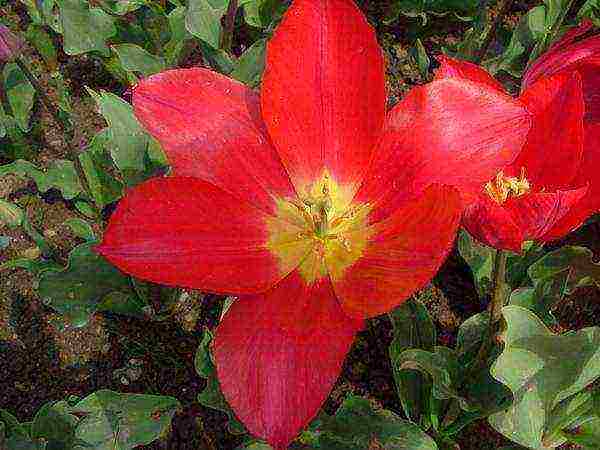
Tulip Madame Curie cultivar The cultivar is medium-sized, 50 cm high, the stem is strong. The flower is goblet, with pointed petals, up to 8 cm high, dark crimson. Dissolves from the 2nd decade of April; flowering up to 10 days. Resistant to diseases and adverse weather conditions.
Tulip variety 'Snowboard'
An exquisite variety with a strong peduncle up to 55 cm high.

Tulip Snowboard grade White flower, goblet, up to 6 cm high.Blooms in early May. You cannot do without such varieties when creating a white garden.
Tulip variety 'Grandma's fairy tales'
Domestic variety bred in Crimea by L.M. Alexandrova.
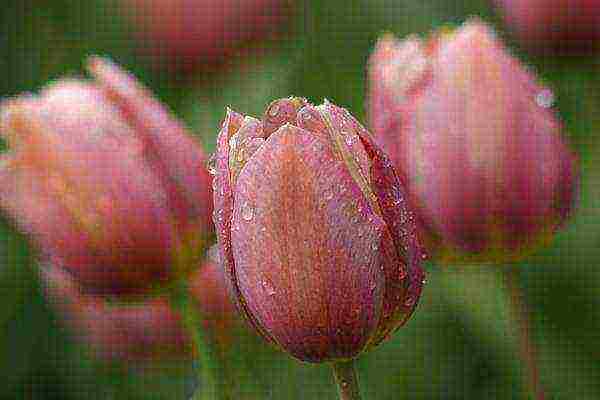
Tulip variety Granny's fairy tales, photo by A. Papkov Plant 50 cm high with a strong stem. The flower is goblet, up to 9 cm high, indescribable by the words of the color "faded grandmother's sundress". Blooms from 2-3 decades of April for 2 weeks. It tolerates well the high temperatures of the soil and dry winds that occur during the flowering period of plants, but in especially hot years, the duration of flowering can be reduced by 2-4 days. Resistant to diseases and pests, to adverse weather conditions. Self-sufficient in spring compositions, good in combination with tulip varieties and other spring-flowering bulbs. Suitable for cutting.
Tulip cultivar 'Orlenda'
This variety is a novelty of Dutch breeding. They predict a brilliant future for him, as they are considered one of the most promising.

Tulip Orlenda cultivar Durable, up to 60 cm high. The flower is bright crimson, with a narrow white border along the edge of the petals. Good for forcing from February to March, well worth cutting.
Tulip 'Staning Apricot' cultivar
A popular cultivar with a strong peduncle about 40 cm high.
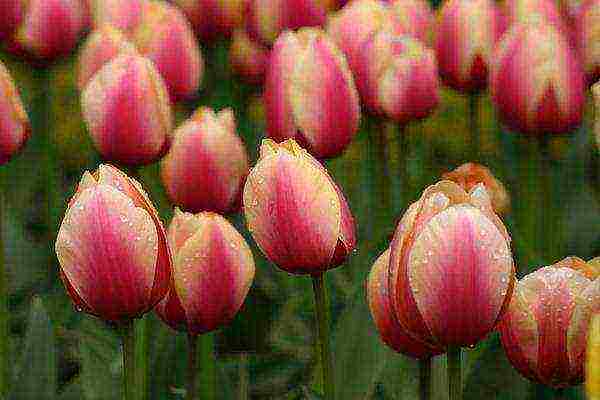
Tulip Staning Apricot, photo by A. Papkov The flower is pink in the center of the petal, and apricot at the edges. A very effective variety! He is simply gorgeous in spring flower beds, borders; it can be grown in containers.
Tulip cultivar 'Anne Claire'
An excellent old-fashioned variety created by Coleen in 1958.
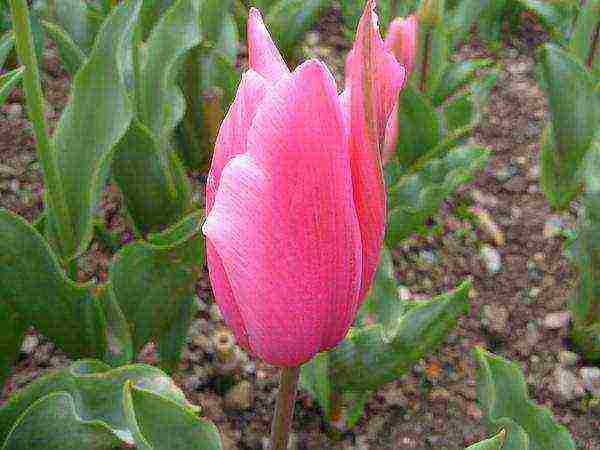
Tulip grade Anne Claire Plant 40-50 cm high; the peduncle is strong, the flower is goblet, up to 9 cm high, red-violet, with light lilac edges of the petals. It blooms in the 2-3 decade of April; duration - up to 10 days. Resistant to adverse weather conditions; can be affected by the variegated virus. Beautiful in spring in a wide variety of flower arrangements, suitable for cutting.
Tulip cultivar 'Preludium'
This variety was created by Koolen in the last year of the Great Patriotic War (1945).

Tulip variety Preludium The stem is strong, 45 cm high. The flower is cup-shaped, large (up to 9 cm high), light pink, along the edge of the petal there is a wide lilac-pink stripe. Blooms from 2-3 decades of April, duration - up to 12 days. Resistant to diseases, but can be affected by the variegated virus; well resists weather whims. Suitable for cutting and forcing from January to March.
Tulip cultivar 'Tamara'
A very fashionable now white and red variety, created by Visser in 1979.

Tulip variety Tamara It is 40-50 cm high. The flower is goblet, large, up to 9 cm high, white, with a wide carmine-red strip along the edge of the petals. Blooms from 2-3 decades of April, flowering duration up to 12 days. Resistant to diseases and weather troubles. Good for cutting and forcing (January to March).
Tulip cultivar 'Emmy Peeck'
Historic variety created by Hybrida in 1949.
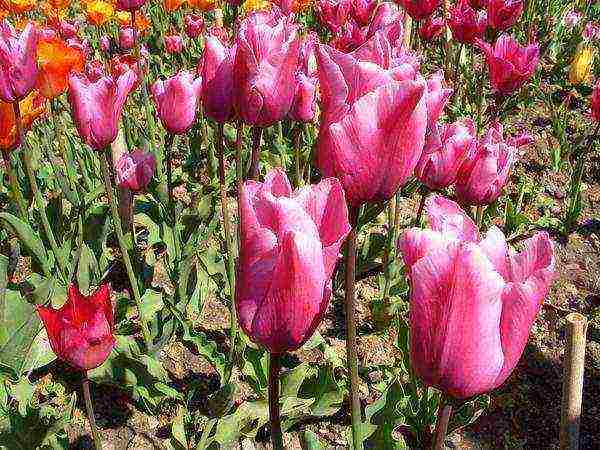
Tulip sort Emmy Peeck Plant 50 cm high. The flower is broadly goblet, large (up to 9 cm high), dark lilac-pink, with lighter edges of the petals. Flowering from the 3rd decade of April, lasting up to 17 days. May be affected by the variegated virus; resistant to bad weather. Good for cutting and in spring flower beds.
Tulip variety 'Pearl'
The domestic variety was created in the Crimea, co-author L.M. Alexandrova.
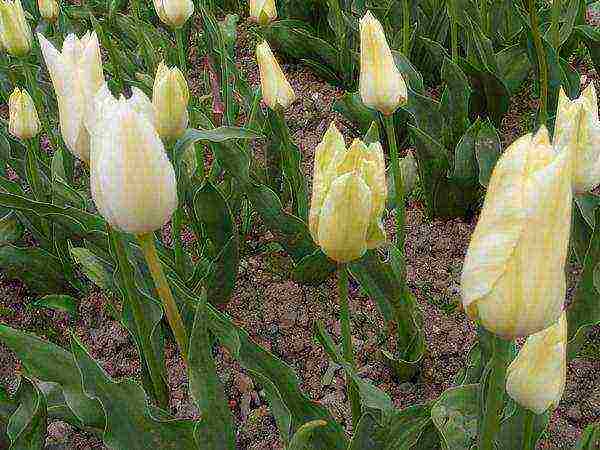
Tulip Pearl grade Stem strong, up to 50 cm high. Goblet flower, 6-8 cm high, white-cream. Blooms from 2-3 decades of April for 2 weeks.
The nuances of tulip culture
- To prevent tulips from becoming smaller, they should be dug up annually.
- It is advisable to dig up the bulbs when the leaves turn yellow. Depending on the flowering period of various varieties, this is the second half of May or mid-June (in Crimea).
- After digging, the bulbs are dried in the shade, in a well-ventilated place, they are cleaned of old mother scales, the new crop is sorted by size and set for storage.
- To avoid the spread of diseases, the bulbs are treated with fungicides; it is useful to sprinkle them with colloidal sulfur.
- During storage, it is very important to observe the temperature regime, which regulates the passage of all organ-forming processes in the bulbs, determining the future flowering and the quality of new bulbs.
- Storage temperature should not exceed + 25 ° С.
Application
Tulips Triumph are good in the spring decoration of the local area, summer cottage, in various mixborders, on flower beds. Suitable for winter-spring forcing (from January to March inclusive) and for cutting.
* Blossoming dates are for the southern regions.
Tulips are often compared in beauty and demand with the queen of the garden - the rose. Many people like the former more, besides, the variety of these colors is striking. In the middle of the 17th century in Holland, the population was literally obsessed with tulips, hundreds of varieties were bred. The excitement is long gone, but the beautiful flowers still delight with their diversity. That is why a classification was created that sorted tulip varieties into groups. Let's get to know them.
It is interesting! There is a legend that happiness was hidden in the bud of a tulip, but no one knew how to open it. Once a kind and pure-hearted boy took a flower, and it opened the petals, making it clear what is important for a person in life.

A bit of background
Until the beginning of the last century, flower growers had no idea how to deal with a wide range of tulips. There are so many varieties that everyone was confused, and the beginning of the creation of the classification fell in 1913. But this business was not so easy for the British and Dutch, and for another 16 years the process could not be completed to the end. As a result, the first register was created in 1929, of course, by now it has undergone a number of changes. After all, some varieties of tulips have outlived their usefulness, some have been discovered yet. In general, there are more than 2.5 thousand of them, but they are all divided into 4 groups in which there are classes, and there are 15 of them now. We cannot list all varieties for you, but below we will introduce you to the most beautiful and popular ones.
On a note! Since there are very, very many tulips in each class, we will name, show photos and describe only a few, but we will list some more. And you yourself, if you wish, can find pictures of varieties on the Internet.
Groups and classes - general description
In this section, we will simply show what the classification looks like, and then we will analyze it in detail. So, tulips are divided according to the following principle.
Group 1. Early flowering.
- Class 1. Simple.
- Class 2. Terry.
Group 2. Medium flowering.
- Class 3. Triumph
- Class 4. Hybrids of Darwin.
Group 3. Late flowering.
- Class 5. Simple.
- Class 6. Lily-colored.
- Class 7. Fringed.
- Class 8. Green-colored.
- Class 9. Rembrandt.
- Class 10. Parrots.
- Class 11. Terry.
Group 4. Types of tulips and their hybrids.
- Class 12. Kaufman.
- Class 13. Foster.
- Class 14. Greig.
- Class 15. Wild.
This is what the classification looks like at the moment. There are many different tulip varieties in each group and class. Let's get acquainted with some of them.
Early blooming tulips
Simple
These are very unpretentious flowers, they easily endure severe winters, bad weather, which is typical of most regions of our country. At the same time, even the wind does not break beautiful tulips, which can reach a height of 25 cm to 40 cm. It is believed that varieties of this class are excellent for decorating borders, garden paths. Flowers love a lot of sunlight, and with it, the buds open as much as possible. Tulips are also suitable for growing in flowerpots, trays on the veranda, and for forcing.
Popular varieties:
- "Gesner". One of the most commonly used tulip varieties in this class. Its shades can be different - both a mix and rich yellow, scarlet;
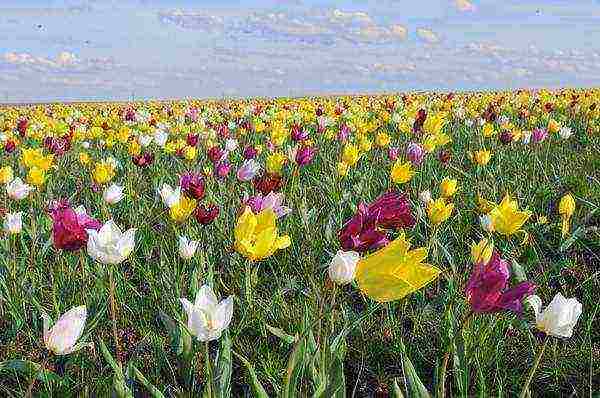 Tulips "Gesner"
Tulips "Gesner" - "Candy Prince". Most often, gardeners plant this variety in order to get chic bouquets from it, since the buds grow on tall and strong stems. A big plus of these tulips is their unpretentiousness. The shade of the petals is a delicate lilac-pink.
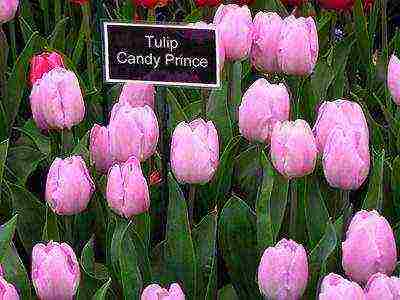 "Candy Prince"
"Candy Prince"
Terry
These tulips do not reach more than 30 cm in height, they delight us with double-type petals, the flowers grow very well, and bloom for a long time.The buds are large - up to 8-10 cm in diameter. Terry varieties always look festive, elegant, elegant and unusual. Tulips of this class serve as an excellent decoration both for flower beds and as a living border.
For information! Bulbous flowers should always be grown where there is no excess moisture, there is plenty of sunlight, and the soil is neutral.
Popular varieties:
- Terry red. It has very large scarlet flowers with double petals, they can reach more than 12 cm in diameter. This is one of the most sought-after varieties;
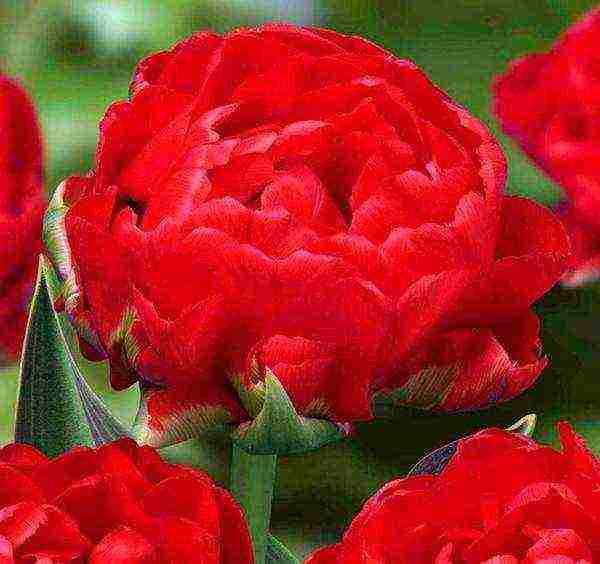 "Terry red"
"Terry red" - "Monte Carlo". These are yellow double flowers - up to 10 cm in diameter. Strong point - resistant stems and immunity to diseases;
 "Monte Carlo"
"Monte Carlo" - Ice Cream. From the name it can be understood that this variety of tulips is compared by breeders with delicious ice cream. All thanks to the unusual combination of shades and the shape of the colors themselves. But these tulips do not like bad weather and high humidity.
 "Ice Cream"
"Ice Cream"Advice! Also take a look at the varieties of this group with the names - "Bonanza", "Dante", "Carlton", "Electra", "Shunord", "Murillo Maxima", "Madame Testu", "Triumfator".
Mid-blooming tulips
As the name suggests, these tulips do not begin to bloom early - in the third decade of May. But sometimes summer residents achieve earlier flowering, in general, gardeners love the flowers of this group. They bloom evenly, the shades delight with their diversity. It is a completely unpretentious group, does not require special care, it tolerates weather adversities well.
Triumph
Tulips of these varieties are well suited for making bouquets - they have tall, stable stems, the correct flower shape - in the form of a wine glass. Bouquets last a long time, they look very decorative.
Popular varieties:
- Denmark. Very beautiful tulips for cutting, and an unusual color - scarlet with a yellow border. Peduncles are tall and strong, the variety does not disintegrate, does not bend;
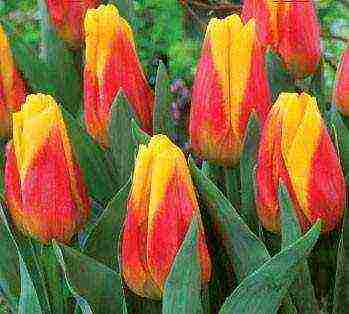 "Denmark"
"Denmark" - "Alexander Pushkin". These tulips can be admired endlessly, just take a look at the rich purple hue and border. It can be white or pinkish. Ideal for bouquets.
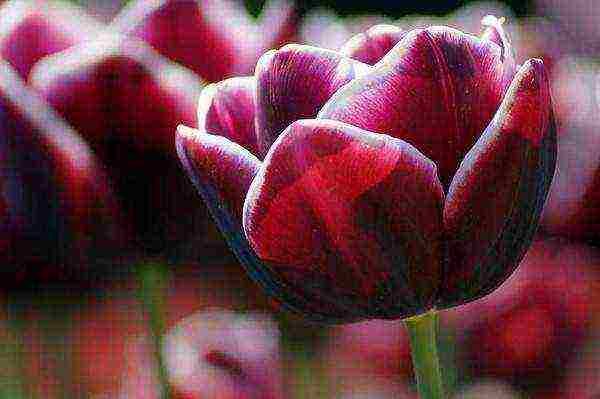 "Alexander Pushkin"
"Alexander Pushkin"
Darwin hybrids
These flowers look beautiful along fences, walls, and can be cut into bouquets. These are giants - up to 80 cm tall. The "glass" of a flower can open wide. Tulips are not afraid of frost and diseases.
Popular varieties:
- "Russian Princess". Has a delicate aroma. The petals are pink-red, the edge is light beige. Ideal bouquets of these flowers for a gift for girls;
 "Russian princess"
"Russian princess" - Eric Hofsue. Pink tulips on high stems. The buds are large, the bouquets stand for a long time. The edging on the petals is light. A popular variety.
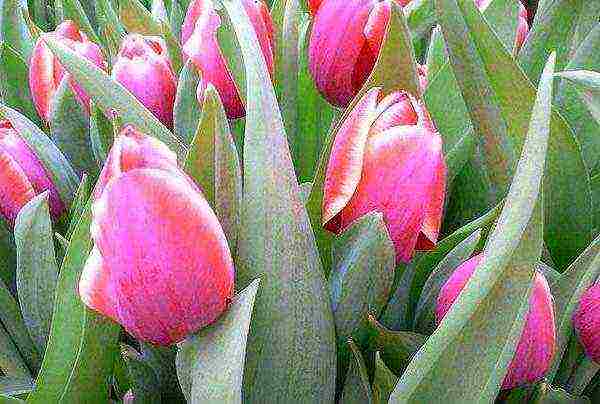 Eric Hofsue
Eric Hofsue
Advice! Also take a look at the following varieties of this group - "Apeldoorn", "Princess Beatrix", "Roland", "Topskor", "Beauty of Apeldoorn", "Diplomat", "Oxford".
Late blooming tulips
It is clear from the name that varieties from this group bloom in late spring and early summer. These tulips love warm and hot weather, but they are very capricious about a drop in temperature and return frosts. Therefore, if you plant such tulips, then follow the forecast in the spring in order to cover the flower beds in time.
Simple
Tall tulips - up to 80 cm. Shades of petals can be different, flowers can be easily bred. The shape of the inflorescence is goblet, at the stem it resembles a square. The flowers are large, beautiful.
Popular varieties:
- Shirley. The splendor of tulips in their light color of petals and stripes that can be purple or lilac. Such flowers can suit brides;
 Shirley
Shirley - "Night Queen". This tulip variety is striking in its sophistication, because the petals are velvety, of a noble burgundy color. The flowers may appear to be black.
 "Night Queen"
"Night Queen"
Advice! Also take a look at the varieties - "Prince Vladimir", "President Hoover", "Artist", "Advance", "Dido", "Rosie Wings", "Georgette", "White City".
Lily-colored
And here scientists gave the name to tulips for a reason. By the shape of the flower, it is clear that these buds resemble lilies, they have sharp tips. The main colors are white, pink, scarlet, yellow.Tulips grow up to 50-60 cm, do not disintegrate. When the buds have fully opened, you can notice that the petals have a second shade inside.
Popular varieties:
- Pretty Woman. Unpretentious variety, it is easy to grow it. The color of the petals is carmine;
 "Pretty woman"
"Pretty woman" - "Ballad". On the petals there is a light stripe along the edge, when like the buds themselves are charming purple. Decorating any garden, prefer a loving care.
 "Ballad"
"Ballad"
Advice! Take a closer look at the varieties - "Aladdin", "Astor", "Alaska", "Kepten Frayatt", "Hedwig Fatter", "White Triumphant".
Fringed
Tulips of this class were created relatively recently - at the end of the last century. The flowers are tall, stately. They can be immediately distinguished by the edge of the petals, where there is a needle-like frill. Varieties bloom at different times - in late spring and summer, shades can be completely unique.
Popular varieties:
- "Mustang". Very beautiful, perfect flowers for gift bouquets. Tulips of this variety stand well, have a rich scarlet color, the petals are very dense;
 "Mustang"
"Mustang" - "Cambridge". These tulips can be white or light beige. The variety is suitable for forcing, has a high decorative appearance due to the frill on the petals. Just look - it's like a wedding dress.
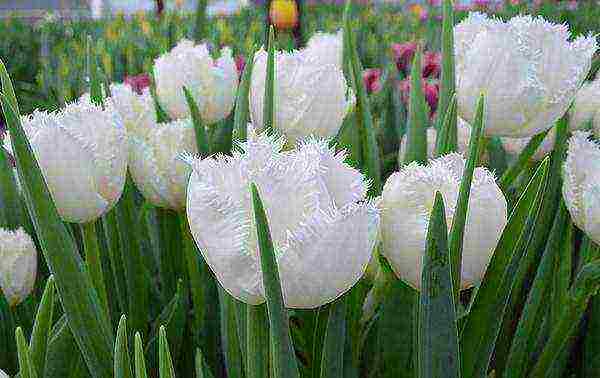 "Cambridge"
"Cambridge"
Greens
There are flowers that are often planted, and there are rare and expensive ones. This class is just that. Breeders bred a number of varieties in 1981, the main distinguishing feature is the middle of the green buds. The petals themselves can be different.
Popular varieties:
- Spring Green. Very beautiful tulips, you can see that they are really unusual. They bloom for a long time, the variety is the highlight of the garden;
 Spring Green
Spring Green - Florosa. Delicate combination of shades. Tulips of this variety are highly valued for their decorative appearance. Great for decorating banquets, weddings.
 Florosa
Florosa
Advice! You can choose other tulips with names - "Artist", "Green", "Greenland", "China Town", "Golden Artist".
Rembrandt
These tulips can create a great mood even on the worst day. They are so different, they can be of any shade, pattern. They bloom in the second decade of May, grow up to 75 cm. Gardeners love them very much.
Popular varieties:
- Sorbet. Luxurious white-red tulips, their buds are striking in their diameter. They do not open completely, remaining in the shape of a wine glass. Ideal for a bouquet;
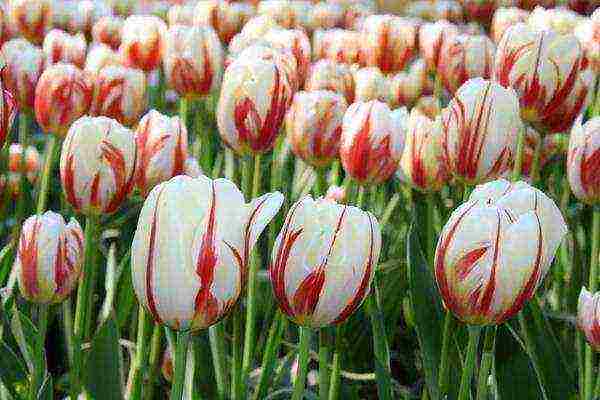 Sorbet
Sorbet - "Princess Irene". Some of the best colors for girls are delicate, mesmerizing. Suitable for cutting, stand well, perfectly decorate the site, shades can be different.
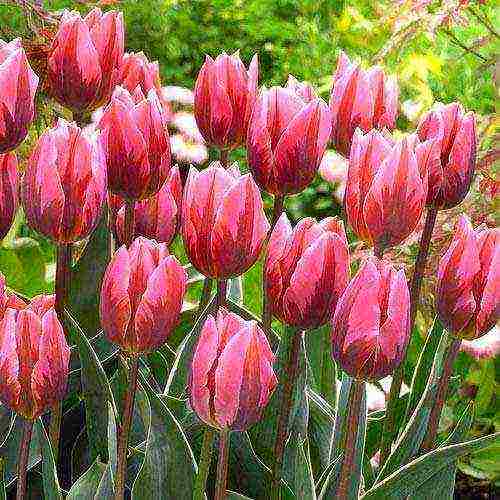 "Princess Irene"
"Princess Irene"
Advice! You can also plant these varieties - "American Flag", "Black Boy", "Montgomery", "Star and Stripes", "Pierrette".
Parrot
The name speaks for itself. Tulips are bright, have unusual petals, the edges of which seem to be indented, it seems that the flowers imitate birds. Loved and in demand among gardeners. They have a high stem - 65-80 cm. After cutting, tulips stand well, only the flowers are fragile and you need to be careful. On the site, they can be planted along the fence, terraces, in conjunction with low-growing varieties of tulips. The diameter of the flowers is up to 20 cm.
Popular varieties:
- "Publicity". It is very often planted by gardeners. He likes his rich red color, beautiful decorative appearance and large buds. Reminds of a flame;
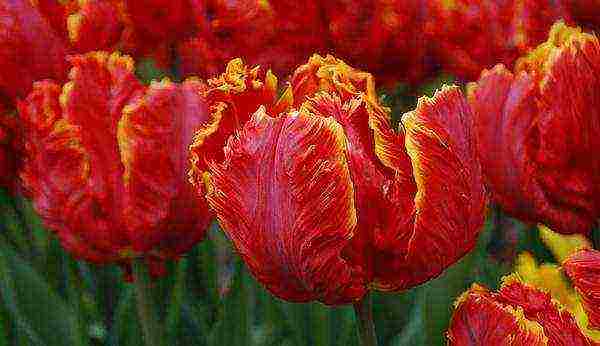 "Publicity"
"Publicity" - Black Parrot. Here, too, no extra words are needed - just look at the color of the petals, which additionally have a velvety texture and a bluish bloom.
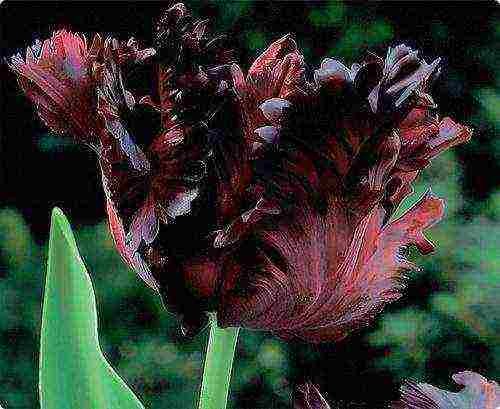 "Black Parrot"
"Black Parrot"
Terry
These tulips have large inflorescences that open very widely. They need a quiet, sunny place on the site so that the petals are not damaged. Shades can be different.
Popular varieties:
- Double Beauty. A sunny shade will brighten any flower bed. Tulips of this variety often have a different combination of patterns on the petals;
 "Double beauty"
"Double beauty" - "Angelica". Beautiful flowers, but it is better not to cut them. Terry buds are often associated by gardeners with an apple orchard during flowering.
 "Angelica"
"Angelica"
Types of tulips and their hybrids
The group has an unusual name, all because all the flowers that did not fall into the previous classes were assigned here. There are a lot of varieties here. We will name the main types of tulips, look at their photos. There are only four names, but there is a wide variety of flowers themselves, since breeders mix them with each other. Tulips are different, the flowering time can be both early and late. Of course, the varieties are also different in appearance.
Kaufman
As a rule, they are pleased with flowering already in April. Flowers are undersized, ideal for decorating borders, can be grown in trays on summer verandas. The shape of the inflorescences resembles a star. They can decorate rockeries, alpine hills, they are not afraid of shadows. These tulips are crossed with the next two and get different hybrids. The class was bred in 1877.
 One of the Kaufman varieties
One of the Kaufman varieties
Foster
Tulips are large - up to 15-18 cm in diameter. They bloom in spring, they are often planted in composition with other primroses or flowers that open their buds in early summer. Shades of petals can be different, varieties are not afraid of frost. In culture, since 1905.
 Foster's tulips
Foster's tulips
Greig
Most often, tulips have either two shades on one flower, or they are just red. Ideal for decorating paths, can be planted at the base of the rock garden. Inflorescences are large, unpretentious class with strong stems. The petals have jagged edges. The class is used for crossing with Kaufman and Foster tulips. In culture since 1872.
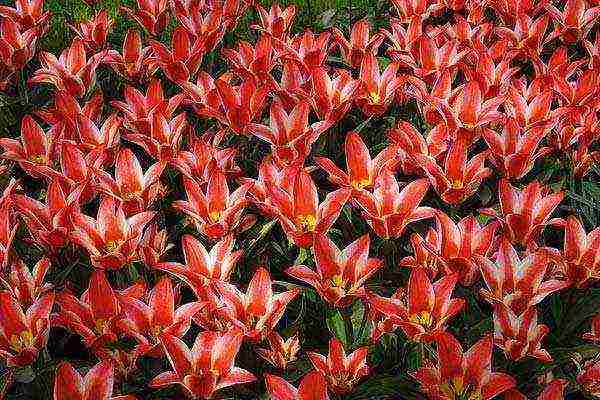 Greig's tulips
Greig's tulips
Wild
These tulips have also been classified, but many varieties are quite unremarkable when compared to other groups. It is worth noting that the three classes listed above are also classified as wild - Kaufman, Foster, Greig. The group also includes tulips - "Borshcheva", "Alberta", "Velikie", "Tubergena", "Julia" and a number of other varieties. Not all flowers surprise with shades, saturation, petals can be small in size. But on the other hand, these tulips are absolutely unpretentious, that's why they are wild. They can bloom up to a month in time. Breeders use wild varieties to create new hybrids.
 Natural flowering
Natural flowering
To get luxurious tulips not only in spring and summer in flower beds, but also throughout the year for the holidays, gardeners are engaged in forcing. That is, you can grow bouquets when you need them. The process is simple, but it needs to be well understood once. There is also an important point - not all flowers can be grown at home in trays. If you want to get bouquets by March 8, then for distillation use the following tulip varieties - "Aruba" (raspberry), "Beauty Trend" (delicate white-pink), "Kasharel" (double pink), "Fest rosie" (pink ), "Lyuba" (like a flame), "Red Power" (scarlet), "Rems Favorite" (violet-white), "Strong Gold" (yellow).
That's how many varieties we have learned. Pick your favorites and plant in the coming season.
Moscow, Russia, on the site since 11.01.2017
Tulips are delicate beautiful flowers associated with spring and festive mood. We invite you to learn more about the different types of tulips that can decorate your garden in the future.
By the way, not only women love tulips. An interesting fact is that these flowers were very popular with the philosopher Voltaire, Cardinal Richelieu, writer Hans Christian Andersen and Emperor Peter I, who loved to admire tulips while walking along the cobbled streets and avenues of St. Petersburg.
To make it easier for you to navigate in a huge number of tulip varieties and make the right choice, use our table.
|
Group I (early flowering) |
Group II (medium flowering) |
III group (late flowering) |
IV group * |
|
1 class - simple early tulips; 2nd grade - double early tulips |
Grade 3 - Triumph tulips; 4th grade - Darwin hybrids |
Grade 5 - simple late tulips; 6th grade - lily-colored tulips; 7th grade - fringed tulips; 8th grade - green tulips; Grade 9 - Rembrandt tulips; Grade 10 - parrot tulips; Grade 11 - double late tulips |
Grade 12 - Kaufman tulips, their varieties and hybrids; Grade 13 - Foster's tulips, their varieties and hybrids; Grade 14 - Greig's tulips, their varieties and hybrids; Grade 15 - other species, their varieties and hybrids |
* All wild species, as well as tulip varieties that were obtained by crossing varieties from the first three groups.
Grade 1 - simple early tulips
Tulips of this class have low (30-40 cm) and strong peduncles. The flowers are shaped like a white wine glass and are most often colored warm yellows and reds.
Simple early tulips bloom in late April. They can be grown both in a flower garden in the country and in containers at home. These flowers look great in borders.
Simple early tulips are not very suitable for cutting. If you want them to delight you at home, use them for distillation (they bloom in January-February).
Simple early tulips include the following varieties: Ruby Red, Prince of Austria, Prins Carnaval, Pink Trophy, General de Wet, Flair, Diana, Couleur Cardinal, Christmas Marvel, Hadley.
Simple early tulips
Grade 2 - double early tulips
Double tulips are popular for their bright colors and early flowering. They do not fade for a long time, they can reach 8 cm in diameter (when opened) and do not grow above 30 cm.
Their stems are strong enough, but they can bend under the weight of the buds. Terry early tulips bloom in late April.
Tulips of this class are ideal for growing in containers. They are also suitable for forcing in January-February. Of course, they can also be planted in flower beds, but only in the foreground. Otherwise, this beauty will be lost among higher cultures.
Terry early tulips include varieties: Abba, Monte Carlo, Queen of Marvel, Montreux, Orange Princess, Monsella, Verona.
Terry early tulips
Grade 3 - Triumph tulips
Triumph tulips were obtained by crossing varieties belonging to the classes of Darwinian hybrids and simple early tulips. These tulips have rather tall stems (can reach 70 cm in height) and large goblet buds.
Varieties of the Triumph class bloom in late April - early May, flowers last a long time and keep their shape well. Growers prefer this class of tulips most often for their varied color, which ranges from pure white to deep purple.
Triumph tulips look good in flower beds, are suitable for cutting, as well as forcing in the middle and late periods. The class is considered the most numerous - it combines 25% of all known tulip varieties.
The Triumph tulips include varieties: Akela, Arabian Mystery, Barcelona, Wonderful, Golden Melody, Cream Perfection, New Design, Oscar, Purple Prince (Parple Prince), White Dream (White Dream).
Triumph tulips
Grade 4 - Darwin hybrids
The class of Darwin hybrids includes varieties that are rather large in size: they can reach a height of about 70-80 cm, and the buds have an average diameter of about 10 cm.
These tulips bloom mainly with red or pink flowers, but now you can find spectacular two-tone varieties.
Almost all varieties bloom in early May. In hot and sunny weather, the flowers open quite strongly (like a poppy) - this is a drawback of this class. But the advantages are much more: the plants can withstand recurrent spring frosts, stand for a long time in the cut, and are also rarely amazed by the variegation of tulips.
Tulips of the Darwin's hybrids class often decorate the sites.They are used for forcing for the spring holidays, so that men can please their beloved women with delicate flowers.
TO Darwin hybrids varieties include: Apeldoorn, Golden Apeldoorn, Oxford, Pink Impression, Golden Parade, Apeldoorn's Elite, Parade, Striped Apeldoorn Beauty of Apeldoorn (Beauty of Apeldoorn).
Darwin hybrids
Grade 5 - simple late tulips
These are tall tulips that can grow up to 75 cm in height. The varieties are distinguished by large, goblet-shaped flowers with a square base and petals with blunt tips.
Simple late tulips have a variety of colors, including two-tone. This class also includes multi-flowered tulips (multiflora), which can have several buds on one peduncle at once.
These flowers are used for landscaping the backyard. Many of them are suitable for forcing, and the strong stalks make these flowers also suitable for cutting.
The class is considered one of the most numerous.
Simple late tulips include varieties: Avignon, Dreamland, Red Georgette, Queen of Night, Maureen, Orange Bouquet, Primavera, Shirley.
Simple late tulips
Grade 6 - lily-colored tulips
This is one of the most original tulip classes. This is the "fault" of flowers of an unusual shape, reminiscent of lilies: the buds consist of pointed bent petals. It is for this cute feature that they got the name "lily flowers".
The varieties of these tulips are distinguished by their high growth (50-60 cm) and various flower colors. They bloom in the second half of May.
This class is considered one of the smallest. However, this does not prevent flower growers from actively using the varieties included in it for landscaping gardens, cutting and forcing. The result is always amazing - these tulips are very beautiful.
TO lily-colored tulips include: Aladdin, West Point, China Pink, Maytime, White Triumphator, Ballade.
Lily tulips
Grade 7 - fringed tulips
A very beautiful class of tulips - the edges of the petals are decorated with a sharp "fringe". On buds of any color (from white to dark purple), it creates the illusion of frost.
In height, fringed tulips reach 60-80 cm. The sizes of flowers may vary depending on which classes of tulips were used in breeding a particular variety. And this, in turn, affects the timing of flowering and the purpose of plants.
Cultivars of fringed tulips produced by crossing late tulips are suitable for cutting. Crossing Darwin hybrids results in fringed varieties that are good for forcing.
Fringed tulips include varieties: Blue Heron, Davenport, Canasta, Fringed Elegance, Black Jewel, Huis Ten Bosch, Burgundy Lace, Maja ), Valery Gergiev (Valery Gergiev).
Fringed tulips
Grade 8 - green tulips
Tulips of this class got their name because of the unusual green back of the petals. By the way, it persists during the entire flowering period. Just look at how spectacular the transitions from green to white, yellow, pink, red and other colors look!
The height of green tulips varies from 50 to 80 cm. The flowers are usually large, with a thickened green center, the leaves are narrow and small.
Varieties of this class bloom from mid-May. They are actively used for landscaping a personal plot, as well as for drawing up original bouquets.
TO green tulips include varieties: Artist, Spring Green, Greenland, China Town, Golden Artist, Florosa.
Green tulips
Grade 9 - Rembrandt Tulips
All variegated varieties belong to Rembrandt tulips. Some inexperienced growers may confuse this class of tulips with flowers affected by variegation.
It is important to remember that in varieties of this class, the spots and strokes on the petals are fixed at the genetic level.
The flowers of tulips of the Rembrandt class are large, have a goblet shape and are distinguished by spots and stripes that contrast with the main red, yellow or white color.
The height of the plants varies from 40 to 70 cm. They bloom from mid-May.Perfect for planting in flower beds and flower beds and for cutting.
Rembrandt tulips include varieties: Prince Carnaval (simple early), Ice Follies (Ice Follis) (Triumph), Sorbet (Sorbet) (simple late), Orange Bowl (Orange Bowl) (Darwin hybrid), La Courtine (La Curtin) (simple late ), Mona Lisa (Mona Lisa) (lily-colored), Olympic Flame (Olympic Flame) (Darwin's hybrid), Princess Irene (Princess Irene) (simple early) *.
* in brackets are the classes to which the varieties belong without taking into account their variegation.
Rembrandt tulips
Grade 10 - parrot tulips
Parrot tulips are perhaps the most unusual and exotic among all the other tulip classes. Their petals are deeply cut along the edges or have strong waves, which are very reminiscent of bird feathers.
Parrot tulips bloom late - in the second half of May. Wide-open buds can reach a diameter of 20 cm. As for the color, it can be very different: from pure white to violet-black. The height of the plants is 45-65 cm, however, under the weight of large buds, they can droop.
Parrot tulips are most often used for landscaping parks and gardens (they look best along paths). However, they should be placed away from other tulips.
Parrot tulips include varieties: Rococo, Flaming Parrot, Texas Gold, Black Parrot, Fantasy, Apricot Parrot, Estella Rijnveld, Blue Parrot ), Texas Flame (Texas Flame), Weber's Parrot (Weber's Perrot).
Parrot tulips
Grade 11 - double late tulips
Representatives of this class have dense double flowers that resemble peonies. Hence the second name of these tulips "peony" came from.
They differ from double early tulips in their larger size and late flowering period: the buds bloom only in the second half of May.
Tulips have strong flower stalks (45-60 cm), but even they sometimes are not able to withstand huge lush buds. This is perhaps the only drawback of the class. But it can be eliminated by planting the bulbs in areas of the garden protected from wind and rain.
The color of double late tulips can vary from white to black, and there are also very beautiful two-tone varieties. These tulips are used most often for park landscaping and garden cultivation.
Terry late tulips include varieties: Blue Diamond, Wirosa, Casablanca, Negritta Double, Sun Lover, Bonanza, Black Hero, Orange Angelique, Charming Lady (Charmin Lady), Uncle Tom (Uncle Tom).
Terry late tulips
Grade 12 - Kaufman tulips
This class of tulips boasts the earliest flowering dates: the first buds begin to appear as early as early April. The flowers are large, elongated, star-shaped when opened. The height of the stems varies from 15 to 25 cm.
The color scheme is very diverse: more often the buds are two-colored, but they can also be red, yellow or pink. The leaves of Kaufman tulips have purple stripes and specks.
They are successfully grown on an alpine slide and in rockeries. They look great in borders and trunk circles.
Plants are resistant to variegation.
Kaufman tulips include varieties: Giuseppe Verdi (Giuseppe Verdi), Cluck (Clack), Fashion (Fashion), Heart's Delight (Herts Delight), Johann Strauss (Johann Strauss), Showwinner (Showwinner).
Kaufman tulips
Grade 13 - Foster's tulips
Foster's tulips are distinguished by larger buds in the shape of a bowl and a glass (when compared with Kaufman's tulips). The flowers are very elongated and can reach 15 cm in diameter. The color of the buds is most often red, but there are also yellow and pink colors.
Tulips grow to a height of 30-50 cm. They bloom in late April - early May. The leaves have purple spots and streaks.
These tulips are suitable for growing in a flower bed, alpine slide or curb.
Foster's tulips include varieties: Yellow Purissima, Madame Lefeber, Orange Emperor, Orange Brilliant, Sweetheart, Purissima, Candela.
Foster's tulips
Grade 14 - Greig's tulips
These are low-growing tulips no more than 35 cm high. Their flowers are large, with a wide base, the tips of the petals are slightly bent.Most often they are red, but there are varieties of orange, as well as beautiful two-tone options.
Greig's tulips are distinguished by their mottled foliage. They bloom immediately after Kaufman tulips (late April - early May). Flowers do not fade for a long time.
Like the tulips of the previous class, Greig's tulips look great in a regular flower garden, on an alpine slide or in a curb.
Greig's tulips include varieties: Ali Baba, Orange Toronto, Pinocchio, Toronto, Sweet Lady, Oriental Splendour, Cape Cod.
Greig's tulips
Grade 15 - other types
The class combined all other species and varieties of tulips that grow in the wild. For the most part, they are all undersized, bloom early and differ in the variety in the color of the buds.
There are also many-flowered species (multiflora) among wild-growing specimens. When growing tulips of this group on the site, it is best to plant them on an alpine slide or in a rockery.
To this group tulips include the following varieties: Little Princess, Turkestanica, Saxatilis, Dasystemon Tarda, Humilus Odalisque.
Other species, their varieties and hybrids
As you can see, tulips are so diverse that every grower will certainly find a suitable variety in color, size, shape and other criteria.
By planting representatives of different groups on the same flower bed, you can make an amazing flower garden out of tulips alone. They will delight you with bright flowering and pleasant aroma.
In the spring, missing the warmth and flowers, we meet bulbous primroses with special tenderness and joy. The largest of them are tulips (Tulipa L.). This wonderful noble flower needs no introduction, it is familiar and loved by everyone. Since ancient times, wild tulips have grown in the forests, then, with the light hand of Peter I, their most beautiful hybrids gradually began to enter our lives. Now there are a huge number of tulip varieties and new ones are constantly appearing. It is not surprising to get lost in such a variety. Scientists have created a classification that can help amateur gardeners choose the right varieties of these flowers for their site.
General overview of the classification
 From 1913 to 1929, botanists and plant breeders in Holland and England worked to create a classification of the species and varieties of tulips that existed at that time. Since then, it has been periodically updated - new varieties are added and outdated ones are excluded.
From 1913 to 1929, botanists and plant breeders in Holland and England worked to create a classification of the species and varieties of tulips that existed at that time. Since then, it has been periodically updated - new varieties are added and outdated ones are excluded.
The modern international classification divides tulips into 4 large groups, which, in turn, are divided into classes (15 are highlighted). The division of this plant into groups was based on the timing of their flowering. The only exception is the last (fourth group), which includes wild species and all varieties of tulips derived from them.
We propose to consider together in more detail all positions of this classification. And the presented photos and names of varieties will make our review more informative.
Early flowering tulips. Group-I
The first group is made up of early flowering tulips. It is divided into two classes - simple and terry.
Class-1. Simple early flowering
Simple early flowering tulips (Tulipa single early) have been known for a long time, since the times of Peter the Great. They are strong and hardy, they are not afraid of spring weather, therefore they are very popular. They reach a height of 40 cm. The flowers are in the shape of a glass or a bowl and tend to open completely. The color is dominated by bright and warm yellow-red tones. Flowering begins around mid-April. Tulips of this class will decorate a spring flower bed with dignity. Looks good in containers and pots. They are often used for winter forcing. But due to the insufficient length of the peduncles for cutting, they are not suitable.
For example, the red-pink Christmas Marvel, bred in 1954, became the basis for the creation of many wonderful sports ("sport" is a plant with characteristics different from those characteristic of this variety, for example, a different color of petals, no border, etc.).One of them is Christmas Dream - a pale pink glass, located on a sturdy 45 cm flower stalk.
Large and wide glasses of Pink Trophy attract attention with a lilac-pink hue. A sea of bright sunny colors will add a motley red-yellow Mickey Mouse to the garden.
The very popular and unpretentious plum-red tulip of the Couleur Cardinal variety is old, its history begins in 1845. But thanks to its highest decorativeness and simple maintenance requirements, it is still actively cultivated. A low (up to 30 cm) peduncle makes it convenient for creating flower beds, borders, rabatok.
A short, sturdy man (15-20 cm) with elongated glasses of deep red Brilliant Star looks amazing in a group container planting. To match it is the same small, but with a large flower glass, the snow-white Diana variety (bred in 1909).
Delicate and romantic, Olga has a cup-shaped deep pink flower with a white border. Light orange General de Wet, despite its decent age (bred in 1904), will decorate any flower garden with dignity.
Of course, we have named only a few representatives of this class, although it is considered small in number.
Class-2. Terry early flowering
Terry early flowering tulips (Tulipa Double Early) begin their history from about 1613. Its European name "Double Tulips" got due to the special structure of the flower, which has two rows of petals (as if one six-petal flower is in the middle of another). Especially lush varieties have three additional petals. Terry tulips are rather low (up to 30 cm), which makes them unsuitable for cutting, despite the beautiful large flowers (their open diameter is about 12 cm). Often used as a pot culture and for forcing, and in the garden they decorate the front rows of various flower beds with dignity. This class is characterized by long flowering (more than 10 days).
Like simple tulips, double early ones have a strong peduncle, are resistant to spring weather and bloom at the same time. Although sometimes even a strong stem does not hold a heavy, luxurious flower.
The baby (about 10 cm) Abba is very popular, its rich red flowers immediately attract attention. Spring varieties Monte Carlo and Mr. van der Hoef. Raspberry petals with delicate pink edging make up the flowers of the Melrose cultivar. Orange flower lovers will love the stunningly vibrant melon-salmon Monte Orange.
The most delicate colors will give you the light lemon variety Verona, snow-white handsome Mondial, white with small yellow stripes Evita.
This class is also considered not numerous, but the choice is huge.
Although this group is called early flowering, it should be noted that some varieties of tulips of Kaufman, Greig and other botanical species bloom even earlier.
Medium flowering tulips. Group-II
The second group consists of medium-flowering tulips, which are divided into two classes - Triumph and Darwin.
Class-3. Tulips Triumph
Tulips Triumph (Triumph) were withdrawn after 1910, and in 1923 they were first put up for sale and already had their original name. In the process of their selection, simple early tulips, Darwinian hybrids, as well as some old varieties were used. A distinctive feature of this class are high (about 70 cm) rather strong peduncles, large goblet flowers that keep their shape well. The color of the petals can be absolutely any, various shades and their combinations. Long-lasting flowering begins in late April and early May.
All the characteristics of Triumph tulips make them suitable for cutting. They are also widely used in the decoration of flower beds. Can be used for medium to late distillation. Reproduce well vegetatively.
Today, Triumph tulips form the most numerous class.
In order to visually present them to you, it is very difficult to choose several varieties from such a variety and splendor.
It is impossible to pass by the Arabian Beauty tulip.His large (up to 12 cm) light purple glass, thanks to the yellow edge, glows like a magic lamp from the inside. Interesting color in the Roman Empire variety, the red petal on top is decorated with the widest white border.
The snow-white elongated White Dream flower looks very aristocratic. The red, with a velvety sheen of Ben van Zanten will flash brightly on the flowerbed. The sunny yellow Strong Gold will add golden colors to your site, its glass never opens and lasts a long time after cutting. The peach-orange Amazone will provide a positive mood. Lovers of black tulips will be interested in the Ronaldo variety with very dark velvet purple petals.
The unusual shape of the glass with sharp, slightly curved white petals and a pleasant aroma make Agrass White attractive. The pink-lilac variety Barcelona also has a wonderful sweet aroma.
Care and cultivation of Triumph tulips are very simple. They are undemanding to the composition of the soil, they can grow in the shade and even in wind-blown places.
Class-4. Darwin hybrids
Darwin hybrids (Darwin Hybrids) is the most common tulip class, formed in 1960. They are a selection of Darwin and Foster tulips. These hybrids have a high stem (up to 80 cm), a large bowl-shaped flower (about 10 cm). A characteristic feature of the flower is a rectangular bottom, most often black. The petals of this class of tulips are predominantly red, although there are other colors, including two-color ones. Darwin's hybrids do not have only purple-lilac flowers.
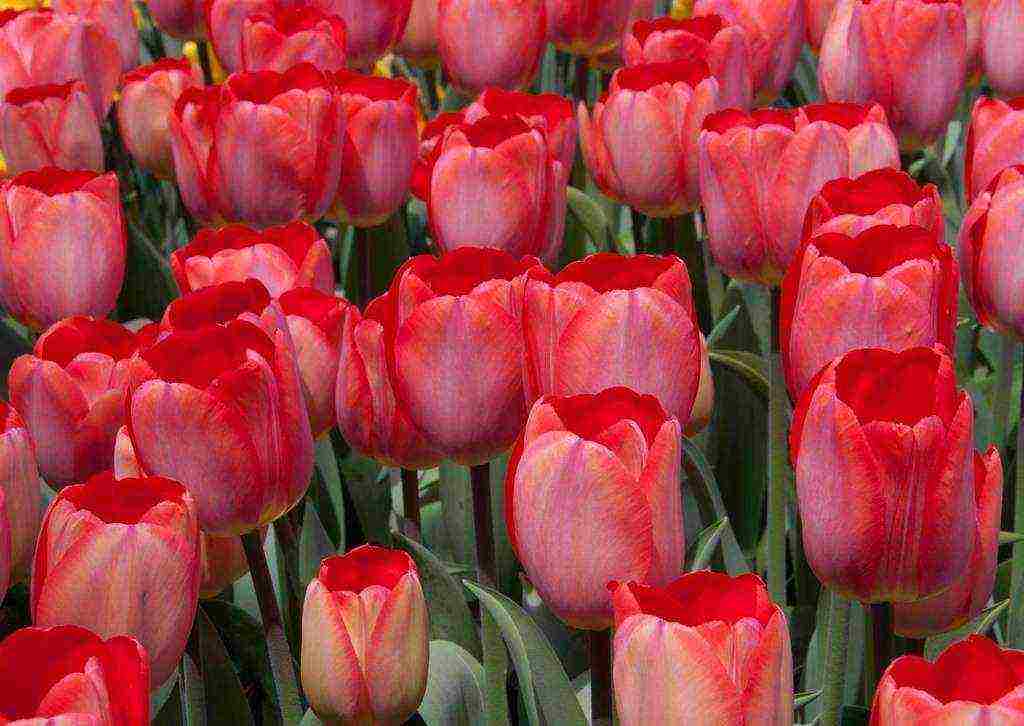
Big chief
The main disadvantage of most varieties of this class is considered to be their ability to fully open on a sunny day, although some people even like it. On the other hand, Darwin's hybrids are resistant to diseases and spring weather, and retain their decorative effect for a long time. They are widely used in spring flower gardens, as well as for March distillation. The varieties of this class are very similar to each other.
The beautiful salmon shade distinguishes the Daydream and Chambery varieties. American Dream has a very elegant glass with an unusual color; a red border looks very impressive on sandy-yellow petals. The tulip Come Back has a royal crimson-red color. Smooth transitions from almost red to pale pink distinguish the color of the petals of the Big Chief variety. The magnificent elongated yellow glass of the Conqueror exudes aristocracy.
The most delicate colors are presented by the following varieties: Hatsuzakura - creamy white with a lilac-pink wide border; ivory Ivory Floradale; snow-white Lanka.
Lovers of dark shades should definitely pay attention to the Gavota variety and its maroon flowers with a yellow border, Armani tulips are dark red with a thin white border.
As you can see, although the flower shape is the same for Darwin hybrids, the variety of colors makes them different from each other.
Late flowering tulips. Group-III
This group is the most numerous and diverse. It included 7 classes - simple, lily-colored, fringed, green-colored, Rembrandt, parrot, terry.
Class-5. Simple late blooming
Simple late blooming (Single Late) combined Darwin's tulips in their class, as well as the old species Breeders and Cottage. The newly formed class is characterized by a fairly high stem (up to 75 cm), large egg-shaped goblets of flowers with an almost square bottom and rounded petals. The color range is not limited, there are also variegated bicolor varieties. They begin to bloom in mid-May. Due to the strong high stem and long-term decorativeness of the flower, they have proven themselves well in cutting and are very popular for decorating plots. But not all varieties are suitable for forcing, since they have a long growing season. This class of tulips is quite hardy against unfavorable conditions.
Blushing Lady yellow with mauve veins, as if shaded with a crimson pencil Hemisphere white flower, a pretty pink and white Aleida with a bronze-yellow border, draw attention to itself with an unusual two-tone color.
Dark colors can be imagined by varieties such as Cafe Noir with its burgundy coffee glasses, black and purple Queen of Night, purple Bacchus.
Light pink Angels Kiss captivate with their tenderness, Renown's carmine-pink bud shimmering with silk, Weisse Berliner white with a light cream shade, and apricot-pink Menton. An unusual shape with bent petals and a lilac-pink, like a porcelain glass in the Picture variety. The snow-white Weisse Berliner will surprise you with its multifloral nature.
Bright and sunny will make your garden rich red with a yellow bottom Wisley, bright red Gordon Cooper, red-pink with a wide orange border Favorite Beauty, salmon orange My Lady, rich yellow with red strokes Hocus Pocus.
Class-6. Lily tulips
Lily tulips (Lilyflowering) came to Europe from Turkey in the middle of the 16th century, but due to poor endurance they did not take root. Later, as a result of selection, quite strong varieties of these tulips were obtained. Now they delight everyone with their lily-shaped glasses with gracefully bent pointed petals. The stems of lily tulips are strong, of medium height (about 60 cm). They bloom in mid-May (right after Darwin's hybrids), the first of the late-flowering class. The color of the flower can be any. Suitable for cutting, and also very intensively used in landscaping. Only some varieties are suitable for forcing.
Lily tulips are very good! For example, the Ballada varietal group represents flowers of various colors - purple with a white border Ballade, purple with a lemon-yellow border Ballade Dream (Sonnet), bright yellow Ballade Gold, orange Ballade Orange (Je t 'aime), white-cream Ballade White, lilac-pink with a wide white border Ballade Lady.
You will feel the splendor of noble red tones with the rich red tulips Red Shine similar to the velvet royal crown, the lighter color of the Royal Gift tulip, the orange-scarlet Cobra, and the dark red Captain Fryatt.
The personification of tenderness can be called the cream variety Elegant Lady, light yellow with a wide white border Budlight, light pink Zantens Memory, ivory Macarena glass, white with pink-raspberry stains Holland Chic.
The variegation will be provided by yellow-orange with a raspberry stripe Marjolein, yellow star-shaped Flashback, salmon Kokker Fan Fan, orange-raspberry Marjan.
Dark tones can be imagined as a velvet purple Burgundy, a contrasting combination of dark purple and white in Akita.
Class-7. Fringed tulips

Warbler
Fringed tulips or orchid (Fringed) - The result of a random mutation of simple tulips. The first such variety was recorded in 1930. Modern breeding deduces them on purpose. Many characteristics of fringed tulips depend on the parent class. For example, the timing of flowering. In total, they are tall (up to 80 cm), the shape of the flower can be goblet, cup-shaped, lily-colored. The main feature that distinguishes this class is the presence of needle-like outgrowths - "fringes" along the edge of the petals. Tepals are stiffer than those of other classes. Varieties derived from Darwin's hybrids are suitable for forcing, while those derived from late tulips are good for cutting.
Fringed tulips are certainly very beautiful, their colors are very diverse. For example, white with purple splashes Aria Card, chic raspberry red Barbados, dark purple Black Jewel, red-brown Labrador, white-pink Crispion Love, cherry with a thin white border New Santa, snow-white Honeymoon, creamy orange Ballroom.
They resemble fluffy chickens yellow Warbler, a pleasant combination of lilac with yellow fringe in Aleppo flowers.
Terry fringed varieties look unusually magnificent - the most gorgeous red-pink Kingston, the most delicate white-pink Queensland, motley red-yellow Bastia, dark red Maroon, foamy white Snow Crystal.
Planting and caring for this class of tulips requires more effort than the original species, in addition, they need careful protection against variegation virus.
Class-8. Greens
Green tulips (Viridiflora), like the fringed ones, is the result of a mutation that was fixed by selection. Green-colored tulips were allocated in a separate class in 1981.They are characterized by their green bottom and green thickened center on the petals, which can be of any color. There are varieties of medium and high heights. The unusual appearance has made these tulips very popular nowadays. They are actively used in decorating flower beds, have proven themselves well in cutting.
Since this class of tulips is young, its varietal diversity is relatively small.
Meet some of the green-flowered tulip class. Delightful and delicate pale orange with rosy Golden Artist, elegant pink Virichic, violet with a silky sheen Night Rider, noble red Eyecatcher. A wonderful lily-shaped flower, painted in several shades of green with a delicate creamy Deirdre border. And the yellow Monte Spider tulip will amaze you with its exotic shape.
Since in their origin green-flowered tulips are similar to fringed tulips, they are also inferior to the original species in hardiness and resistance to variegation virus.
Class-9. Tulips Rembrandt
Tulips Rembrandt (Rembrandt). This class brings together all the petal forms of tulips. Initially, these were Darwin's tulips, infected with the variegation virus. Then this trait was genetically fixed in some varieties. The Netherlands tulip leader banned Rembrandts and stopped growing them. The only exceptions were some old varieties. The characteristic color of their petals includes spots and strokes that make them original. These are medium-sized tulips. Use them with caution in park landscaping. This is the smallest class.
A surprisingly unusual black and white color for the Black and White tulip, Absalon dark reds with yellow touches, Adonis purple with white touches, purple with dark streaks and light yellow Papillion, a raspberry glass with whitish Columbine touches.
If you decide to decorate your site with Rembrandt tulips, then plant them separately, away from other species, to exclude infection.
Class-10. Parrot tulips
Parrot tulips (Parrot) - the most original of all types. Their petals can be of any bizarre shape - twisted-curved, wavy, torn. This class got its name for the similarity of petals with bright disheveled feathers of parrots. These tulips are generally medium-sized (up to 60 cm). Their huge flower heads can reach up to 20 cm and are accordingly heavy. Therefore, when decorating a plot, they should be tied up or planted between other plants that can support them. For the same reason, these tulips should be protected from the winds. They bloom most often in the second half of May.
Let's start our acquaintance with this type of tulips with one of the most exotic - the green-yellow Exotic Parrot. Well, can you tell right away that this is a tulip?
Dark purple frozen Night, blue Blue Parrot, bright yellow Yoko Parrot, fancy purple with white Mysterious Parrot, greenish pink Air, velvet red Rococo (there is also an orange variety), randomly arranged snow-white petals with dark green veins Super Parrot varieties.
True, like tropical birds, the combination of coral red, yellow, cream and green in the petals of the Apricot Parrot. A very unusual one, similar to ice cream in an Ice Cream cup, is very popular.
It blows with spring and tenderness from the peach-yellow tulip Creme Upstar with the lightest crimson blush.
Variegated varieties - red-yellow Double Flaming Parrot and white-raspberry Estella Rijnveld (Gay Presto).
If you want to appreciate the beauty of parrot tulips, then plant them in the foreground separately from other varieties.
Class-11. Terry late
Terry late tulips (Double Late). This class of tulips is very similar in shape to peony flowers, therefore they are also called - peony. They have an average stem height (up to 60 cm) and a very large, densely doubled flower. This and even the timing of flowering, they differ from the early terry.
The large flower bowl of these tulips is very heavy, so they, like parrots, should be tied up, protected from winds and heavy rains.
Due to their characteristics, these tulips are mainly used for decorative landscaping.
The Double Beauty of Apeldoorn variety is unusual for its red-yellow color - these two colors can be located on each flower in their own way, even monophonic (yellow or red) specimens can be found.
Similar to the apple blossom, the pink and white Angelique. Beautiful sandy yellow with green touches of Akebono. Cast in purple velvet Antraciet and Black Hero. Very cute purple Blue Wow. And the petals of the tulip Miranda seem to be made of a bright red satin ribbon.
You can call the original Cartouche a chameleon. At first, the bud is light green with a milky middle, and scarlet drops around the edges. But having blossomed, it becomes snow-white with a wide crimson border.
Yellow with a wide white border Monte Sweet, in addition to a magnificent flower with pointed petals, also has a pleasant sweet aroma.
Species tulips. Group-IV
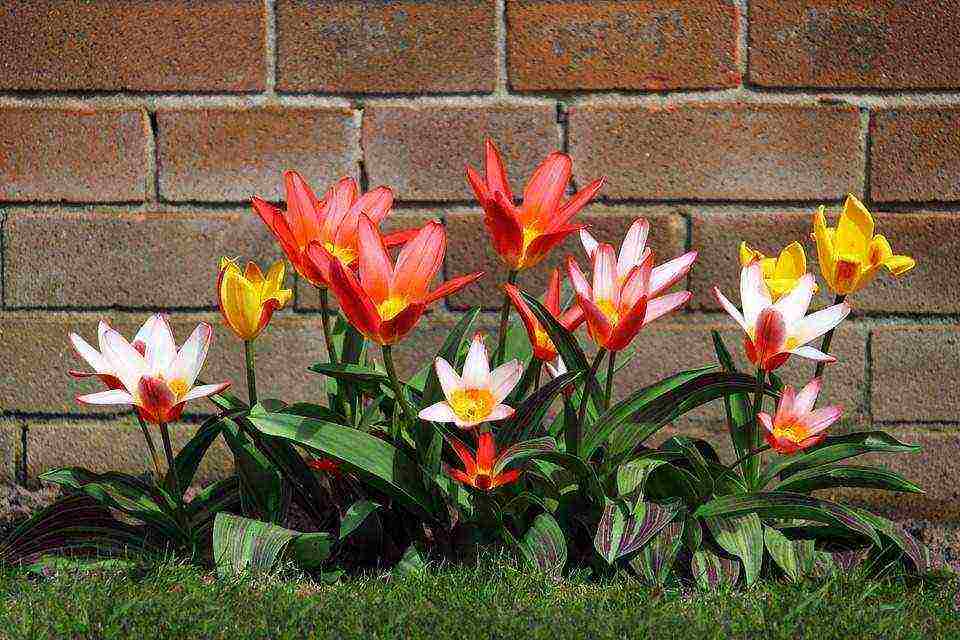
The last group includes wild tulip species and hybrids derived from them. All of them, as a rule, are undersized, resistant to adverse conditions and are in great demand in landscape design. Many-flowered specimens are also found among them.
Class-12. Kaufman tulips
Kaufman tulips (Kaufmanniana). This class of tulips is considered a primrose and blooms in March in warm climates. The height of the peduncle ranges from 8 to 32 cm (depending on the variety). The flower glass is large enough for a low-growing plant (up to 8 cm). After the flower is fully expanded, its pointed petals form an asterisk. Some varieties (hybrids with Greig's tulips) have very decorative leaves with brown, purple or purple stripes and spots.
This class is resistant to variegation virus. Grown as a pot culture. Such tulips are irreplaceable in alpine slides, rockeries and other flower beds where low-growing plants are required. These flowers can be used to decorate the tree trunk circle.
The Shakespeare variety has an unusual shade of orange, inside the flower there is a yellow center, framed by a red border. A real star is formed by the tulip Corona, in the yellow center there is an accent with red strokes, and red flames flare up on the outside on a cream background. The white and red elongated goblet is of the Ancilla cultivar.
A highly elongated glass of reddish-pink hue makes the short Pink Dwarf very unusual.
The little Scarlet Baby, despite her short stature (15 cm), has a long graceful glass of pinkish-salmon color that is half her height.
There are also terry varieties of Kaufman tulips. For example, deep red Holland Baby, lemon yellow with white Calimero border.
Class-13. Foster's tulips
Foster's tulips (Fosteriana). This class is made up of all varieties and hybrids of Foster tulips. In comparison with Kaufman tulips, they are taller (30-50 cm), have a very large elongated flower (up to 15 cm). In addition, flowers of this class have a special shape with slightly bent outer petals. Hybrids with Greig's tulips inherited the striped leaves, which makes them even more decorative. Bloom in April. They are quite well resistant to variegation virus and bad weather.
Unfortunately, this type of tulip has recently become much less grown. Although it will perfectly decorate any flower garden, and some varieties are even suitable for cutting.
At the end of March, Easter Moon can already please you with its blooming. Its yellow petals are covered with silvery dust.
The most popular variety of Purissim. White (sometimes slightly creamy) Purissima bud about 10 cm high. Flaming Purissima - white with dense pink shading, looks very original. Yellow Purissima petals have a delicate shade of lemon yellow.
Pink Sweet Sixte tulips are very beautiful. An interesting red with a yellow base and long petals is a very undersized variety Princeps (15 cm).But the bright red Pinkeen is already much taller (40 cm), so it is even suitable for cutting. Graceful white with a deep pink petal center, Border Legend glasses can also be used for cutting. Red-orange with a large yellow bottom, Juan boasts wide maroon stripes on the leaves. It resembles a parrot look, a white terry tulip Exotic Emperor with a yellow-green center.
Class-14. Greig's tulips
Greig's tulips (Greigii). This class also includes all hybrids of a given species. The height of these tulips ranges from undersized to 50 cm. The flowers are large, mainly in red-yellow colors. They bloom early, just behind the Kaufman tulips. A distinctive feature is the brownish-red patterns on the leaves and the often slightly pubescent stem. They are used on alpine slides, rockeries and other flower beds. Their beautiful flowers and ornamental leaves often adorn the foreground of various flower beds. In addition, their flowering is very long, the buds do not fade for a long time.
The medium-sized (35 cm) variety White Fire attracts attention with its white-cream petals, which are decorated with bright red narrow stripes. Very delicate, medium-sized apricot pink with pointed ends of Fur Elise petals. The bright and sunny red-yellow Chierful has a beautiful glass with rounded ends and slightly curved outer petals. The red-and-white Czaar Peter glasses expand their buds and become even more attractive. A raspberry red with a white border around the edge of the petal, Cha Cha Cha is suitable for cutting. Undersized (up to 20 cm) Donna Bella, thanks to the wide dark red stripe in the middle of each vanilla-yellow petal, seems to be in a dark frame.
Double Toronto is a very beautiful double reddish-salmon variety. Terry varieties of Greig tulips represent scarlet Dubbele Roodkapje (Double Red Riding Hood) with a beautiful pattern on the leaves, as well as an unusual pink-white-blue-red-yellow, with a smooth transition of the most delicate shades of Easter Egg Mix.
Class-15. Wild tulips
Wild (botanical) tulips (Other species). This team included all types and varieties of tulips that were not included in the previous classes of the fourth group. As a rule, these are wild species and their hybrids. The name "botanical" is used for these tulips. Most of them are short, but there are specimens of medium height. The color is varied, there are many-flowered varieties. These tulips bloom predominantly early. This class is simply irreplaceable in landscape design when decorating rockeries, alpine slides, rocky gardens, as it carries the fragile beauty of the wild.
Similar to a mountain flower, white with a yellow center on the inside and reddish brown outside, the Tarda tulip. Delicate, lilac-pink with a large yellow center Bakeri Lilac Wonder. The baby Little Beauty is unusually beautiful, its flower star in the middle is dark blue, then turns into a pale pink hue, and the main part of the petal is crimson. Praestans Zwanenberg, Red Hunter have bright red flowers. Purple with a yellow center, a very miniature Humilis Persian Pearl. The most delicate shade of creamy pink in the elongated Little Girl glasses clearly justifies its name, moreover, this wonderful variety is multi-flowered. The little princess Little Princess pleases the eye with orange stars with an expressive black center.
The very unusual tulip Acuminata belongs to this group. It has narrow, long red-yellow petals, and the ratio of colors can vary, each copy has its own color proportions.
A hybrid of dwarf mountain tulips Humilis Tete a Tete forms a lush, almost creeping on the ground, 10 cm high bush similar to peonies, red-purple flowers.
The largest varieties
Tulips are very popular and demanded flowers. They are grown on their plots by many gardeners and everyone dreams of planting the most beautiful flower in their garden.Of course, large-flowered specimens look the most impressive. We will introduce you to some of them.
One cannot ignore the Orange Giant Sunset, the largest flower of Greig's tulip for a long time. The stem is about 40 cm high and the flower glass is 12 cm high, composed of red-orange rounded petals.
The even larger Greig's tulip Casa Grande meets in early spring. Its orange-scarlet glass with a darker center of the oval petal grows up to 14 cm. It is not for nothing that its name is translated “Big House”. The stem is very strong, it can hold a massive flower even in bad weather.
The gigantic variety Temple of Beauty is well known to many tulip lovers. Its flowers are about 14 cm, elongated lily-shaped, orange-pink hue. This variety is classified as a Simple Late Tulip.
Almost all parrot tulips are large flowers. I would especially like to mention the Libretto Parrot. An exotic tulip in shape and color. It has pinkish cream wavy petals with subtle green and hot pink strokes. Glass 8 cm high and up to 20 cm in diameter.
The representative of the Simple late tulips Big Smile amazes with its size. A sunny yellow flower in the shape of a tall glass (up to 16 cm) evokes a positive mood.
Pay attention to the "Russian Giants" variety series. These are large, hardy, strong varieties. It includes: "Soul of Russia", "Dmitry Donskoy", "Marina Tsvetaeva", "Alexander Nevsky", "Pyotr Stolypin", "Catherine the Great", "Prince Vladimir" and others.
Caring for this popular flower is not particularly difficult. The main thing is to choose a good place for planting, do not forget to dig up the plant in the summer and adhere to the timing of planting tulips in the fall.
We tried to analyze what tulips are. Their variety is enormous. We hope that our information and video will help you make a good choice and you can enjoy amazing and beautiful flowers all spring.

